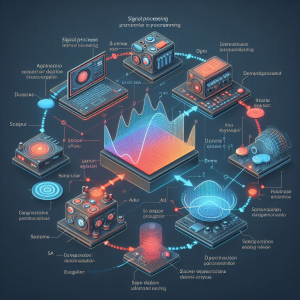Signal processing in artificial intelligence
Signal processing is an important field in engineering sciences and mathematics that deals with the analysis and transformation of various signals such as audio, video, transaction and electronic signals. In this article, we will review the basic concepts of signal processing, methods, and its applications.
The concept of signal processing
In fact, signal processing is a very broad and multidisciplinary field that deals with the analysis and transformation of signals as functions of temporal or spatial variation. This field is used as a basic tool in various fields and plays an important role in analyzing and understanding signal data. Below are some of the fields of application of this field:
Telecommunications: In communication and telecommunications, signals are usually information used to transmit information from one point to another. Signal processing is very important in this field for issues such as sending and receiving signals, coding, modulation and demodulation.
Image Processing: In this context, signals are analyzed as images in digital or analog form. This image information is commonly used for object recognition, medical imaging, satellite imaging and many other applications.
Sound processing: In the field of audio processing, signals are related to sounds and sound waves. This field includes applications such as audio recording, music playback, speech recognition, and sound wave analysis in music and medicine.
medical: In medicine, signal processing is used to analyze biomedical signals such as electroencephalography (EEG) signals, electrocardiography (ECG) signals, and medical imaging signals (MRI and CT scan).
Electrical and Electronic Engineering: In electrical and electronic engineering, signal processing is used in the design of electronic systems, filtering signals, object recognition and control systems.
Geological disciplines: In this context, signals are usually associated with geologic measurements and measurements such as seismology and geologic data analysis.

Also, signal processing as a science has common issues with other fields of engineering and applied sciences and can contribute to a large number of other fields. This field includes various techniques such as Fourier transforms, filtering, pattern recognition, and wavelet analysis and is of great importance in the scientific and industrial communities.
Types of signals
In signal processing, signals are defined in different ways and can be of different types. In this section, some common types of signals and their characteristics will be discussed:
Analog and digital signals:
– Analog signals:These types of signals are extended by continuous variables without interruption. They are usually defined as continuous functions over time or space.
– Digital signals: In contrast, digital signals are represented by digital values or discrete variables. These types of signals are usually obtained by sampling analog signals.Discrete and continuous signals:
– Discord signals: These types of signals change value in certain intervals of time or space and are separated from other values. In other words, their values change only at discrete points.
– Continuous signals: In contrast, these types of signals change continuously in length or space and their values are defined for all possible points in time or space.Video and audio signals:
– Video signals: These types of signals are usually associated with images and represent image information as a matrix of pixels. Images can be black and white or color.
– Audio signals: These types of signals are related to sound waves and represent audio information sequentially from time points. Sounds are usually recorded at different frequencies and different intensities.Transaction signals:
– Transaction signals They pay attention to signal changes in time. These types of signals are very important in telecommunications and data transmission.Comparison of signals and their characteristics:
– In signal processing, comparing and calculating the characteristics of signals is very essential for their analysis and use. These features may include metrics such as frequency, phase, power, energy, temporal and spatial features, and more.
Basic operations in signal processing
In signal processing, basic operations are very important and are used for better analysis and processing of signals. Here are some key basic operations:
Fourier Transform:
Fourier transform is one of the most important signal processing tools. This transform converts time signals into frequency domain. By using the Fourier transform, it is possible to analyze the information at which frequencies are present in the signal and to examine concepts such as the frequency spectrum, impedance, and phase of signals.Wavelet Transform:
– Wavelet transform is a method of analyzing signals into different components based on scale and location. This transformation is very useful for the analysis of complex and multimedia signals (such as images and audio) and allows the detection of different patterns and features.Filtering:
– Filtering means changing or purifying the signal using filters. Filters can be used to remove noise, amplify signals in specific bands, or transform signals to extract specific features.Signal Separation:
Separation of signals means the separation of two or more signals from a signal mixture. This operation is useful for problems where several different signals are combined in one environment. An example of this is the separation of mixtures of sounds or images in signal processing.
These operations allow researchers and engineers to analyze the signals and extract the information they need from them. Also, in various applications from medicine to telecommunications and from geological sciences to music, these operations are widely used and play an important role in signal data analysis.

Applications of signal processing
Signal processing is used in many fields of science and technology. In this section, I will mention some important applications of signal processing and the important issues related to them:
Audio processes:
– Sound processing: In medicine, the processes of diagnosis and diagnosis of diseases are carried out through sound (including audio and loudspeakers).
– phonetic recognition: In pattern recognition systems, people are identified based on voice fingerprints (a process called voice biometrics).
– Speech processing: Converting speech to text (speech recognition) and producing artificial speech are among the most common applications in this field.Image processes:
– Image Processing: Pattern recognition and recognition, image optimization, image correction and image feature extraction are among the common applications of image processing.
– machine vision: In this field, images are used to recognize and interpret patterns and objects with the help of algorithms and neural networks.
– Computer vision: This field is dedicated to image recognition and interpretation in various environments, from object recognition in medical images to artificial intelligence vehicles.Telecommunication processes:
– Modulation and demodulation: In wireless communication, modulation (transforming information into a transmittable signal) and demodulation (extracting information from the received signal) are very important.
– Coding and decoding: To increase communication efficiency and noise resistance, signals are encoded using codes and decoded after transmission.Noise Reduction:
– In many signal processing applications, noise reduction is very important. This application includes cleaning signals contaminated with noise (such as visual images and sound) and cleaning audio signals in noisy environments.Pattern Recognition:
Pattern recognition is one of the main applications of signal processing. This operation deals with the recognition and interpretation of patterns in signals (such as images) for object recognition, face recognition, fingerprint recognition, and the like.Feature Extraction:
– In many problems of pattern recognition and signal analysis, important and possible features are extracted first. These features usually represent specific information of the signal that is useful for detection and subsequent analysis.
Applications of signal processing in different fields not only help to increase the accuracy and efficiency of systems.

Signal processing software and tools
Various software and tools are used for signal processing in various scientific and technological fields. These software and tools allow engineers, researchers and developers to analyze signals and implement algorithms and signal processing models. Two common tools for signal processing include:
MATLAB:
– MATLAB is a programming environment and computing tool that is widely used in various sciences, including signal processing, engineering, mathematics, etc. MATLAB has various tools and functions for signal processing, Fourier transform, wavelet transform, and statistical analysis of signals. It is also possible to access the MATLAB programming platform.Python:
– Python programming language is used as a powerful tool for signal processing and scientific calculations. Several libraries such as NumPy, SciPy, Matplotlib, Pandas, and Scikit-learn are used for signal processing, Fourier transform, wavelet transform, modeling, and data analysis.Octave:
– Octave is an open source environment similar to MATLAB and is used for signal processing and scientific calculations. This software is open source and free and has the ability to run MATLAB codes.Scilab:
– Scilab is also an open source environment similar to MATLAB for signal processing and scientific calculations. This software can also be used as a free alternative to MATLAB.MATLAB Live and Jupyter Notebook:
– MATLAB Live and Jupyter Notebook can be used to create interactive reports and documentation using MATLAB or Python in signal processing. These tools allow users to combine codes, diagrams, and descriptions in an interactive environment.
These software and tools provide wide facilities for signal processing, signal data analysis and implementation of different algorithms in the field of signal processing and create a suitable platform for research and projects related to these fields.
